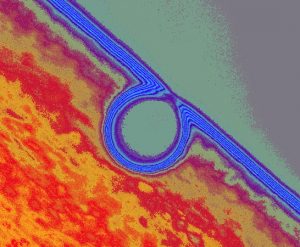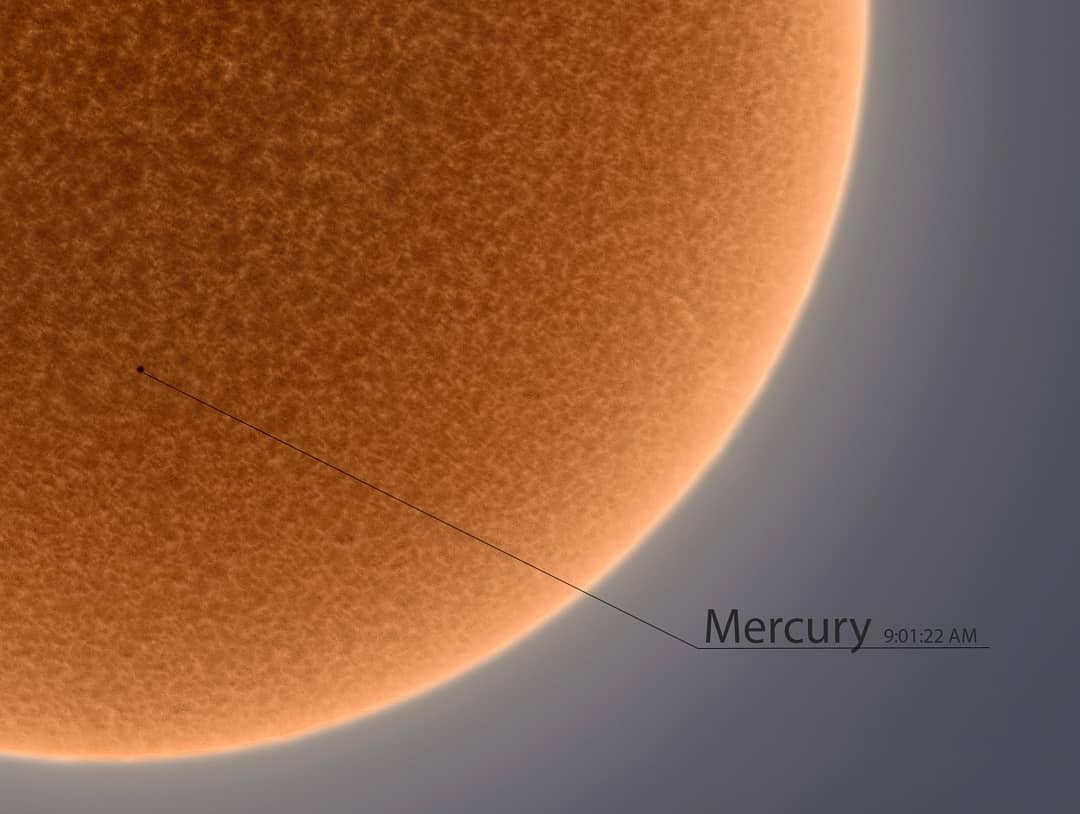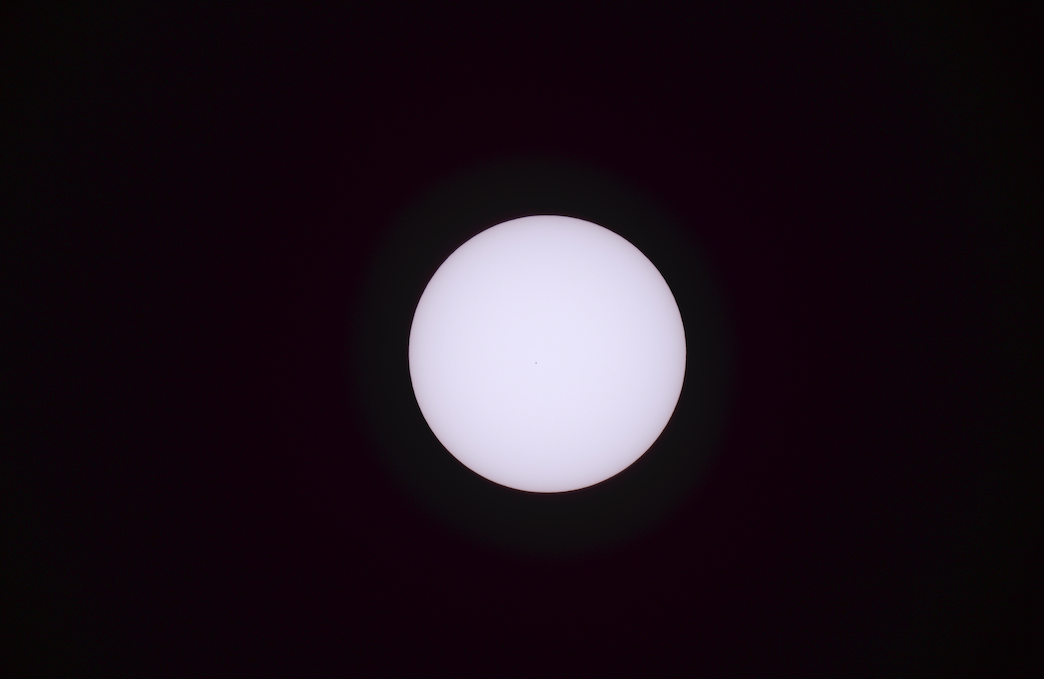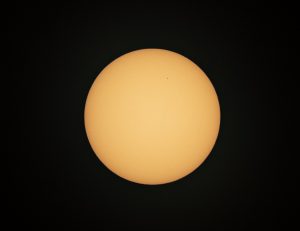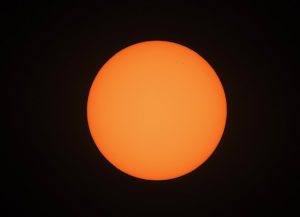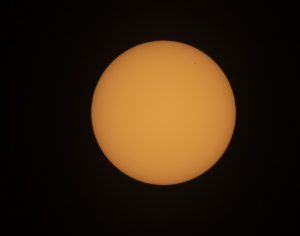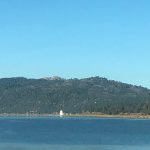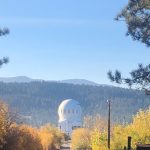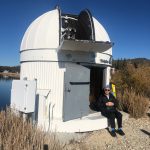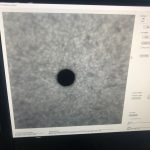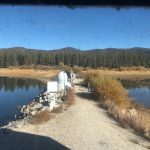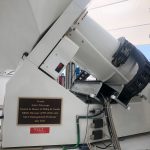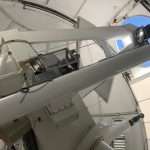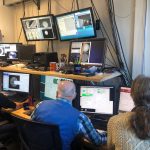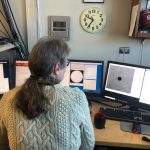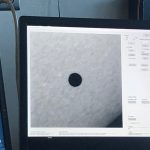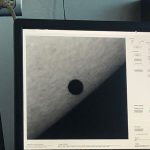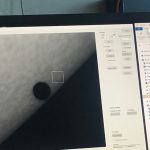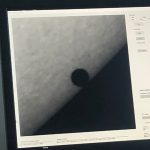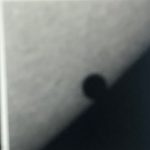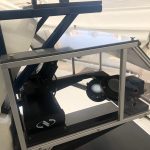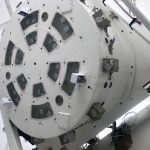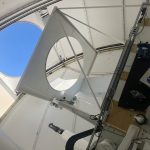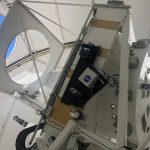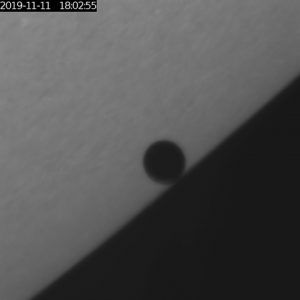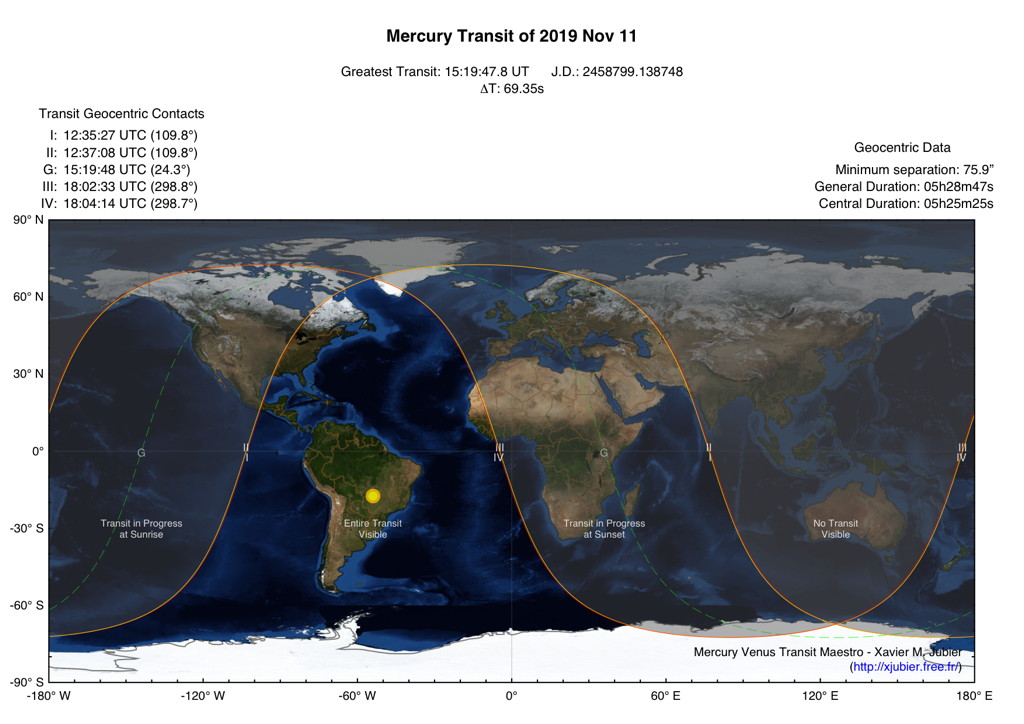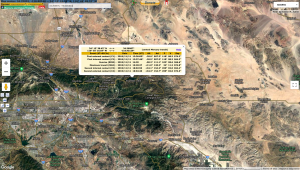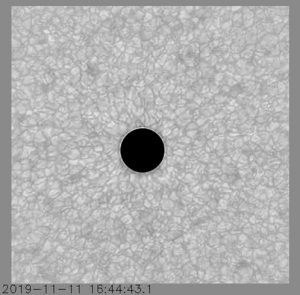
Big Bear Solar Observatory Goode Solar Telescope image from Jay Pasachoff and Glenn Schneider with Claude Plymate, John Varsik, and others from the staff of the New Jersey Institute of Technology’s Big Bear Solar Observatory.
TOM2019 Questar Egress Sequence as Time-Lapse “Movie” FULL LENGTH
Images from Embry-Riddle Aeronautical University by Christian Lockwood, Williams College ’20
Our site on the roof of the astronomy building at Embry-Riddle Aeronautical University was well-situated for observing the transit of Mercury. Initially, there was concern that certain architectural design components on the roof would interfere with the first ~15 minutes of observation, as the transit started very early in the morning while the Sun was low to the horizon, but those fears were unfounded and the transit began just as the disk of the Sun cleared any blockages. We utilized three Takahashi telescopes; one imaged with a high-cadence CCD, another with a normal astronomical CCD, and the final with a Nikon D850. The high-cadence CCD was paired with a H-alpha filter; the other two telescopes took images with a white-light solar filter.
Observation went unimpeded for several hours (during which we saw a SpaceX launch from Cape Canaveral), until a bank of thin clouds moved in and began to block the Sun. To continue making observations, we took manual control of the CCDs and Nikon and increased the exposure time of our frames, using frames taken in the last sequence to approximate the appropriate exposure times of the next sequence. This period of manual management lasted until the end of the transit and produced some of our best observations. Overall, our high-quality equipment and well-chosen site allowed for a successful series of observations of the 2019 Transit of Mercury. – Christian Lockwood, Williams College ’20
- Robert Vanderbei from Princeton, NJ
-
Evan Zucker’s web page of a people montage from Big Bear with us

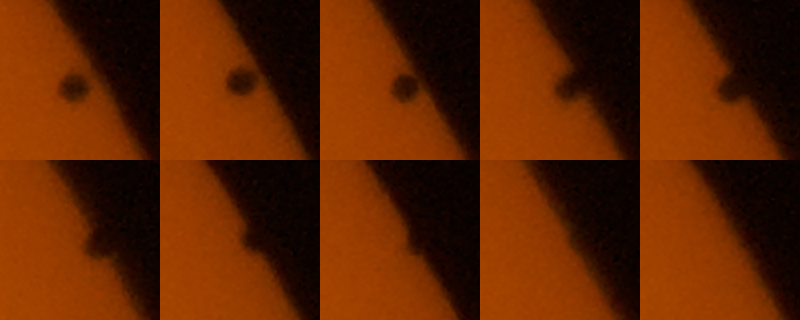 Images by Glenn Schneider with a Questar and a Williams College Questar filter in collaboration with Jay Pasachoff and Bill Sheehan. Quick first reduction. At Big Bear Solar Observatory in a dome alongside the dome of its 1.6-m Goode Solar Telescope. The Questar telescope is 3.5 inch (0.089 meters) diameter aperture. The effective focal length is 1422 mm (f/16). The Questar full-aperture solar filter has optical density 4.8. The camera used was a Nikon D800. Images were taken at 1/1600 s at ISO 500. The full disk image was taken at C3 minus 30 seconds.
Images by Glenn Schneider with a Questar and a Williams College Questar filter in collaboration with Jay Pasachoff and Bill Sheehan. Quick first reduction. At Big Bear Solar Observatory in a dome alongside the dome of its 1.6-m Goode Solar Telescope. The Questar telescope is 3.5 inch (0.089 meters) diameter aperture. The effective focal length is 1422 mm (f/16). The Questar full-aperture solar filter has optical density 4.8. The camera used was a Nikon D800. Images were taken at 1/1600 s at ISO 500. The full disk image was taken at C3 minus 30 seconds.
The egress limb-crossing image sequence is at a 15 second cadence.
Evan Zucker Photographs
- Sony a7iii with Sony 70-300mm lens at 300mm.
- Nikon P900 at 268mm (equivalent to 1500mm with full frame camera)
- Sony RX100iii at 220mm (equivalent to 600mm with full frame camera)
At the Big Bear Solar Observatory, California, with the 1.6 m Goode Solar Telescope
- Full video on Youtube link
Thanks to Claude Plymate, Teresa Bippert-Plymate, John Varsik, Nicolas Gorceix.
Our team: Jay Pasachoff, Glenn Schneider, Evan Zucker, Bill Sheehan, Muzhou Lu‘13
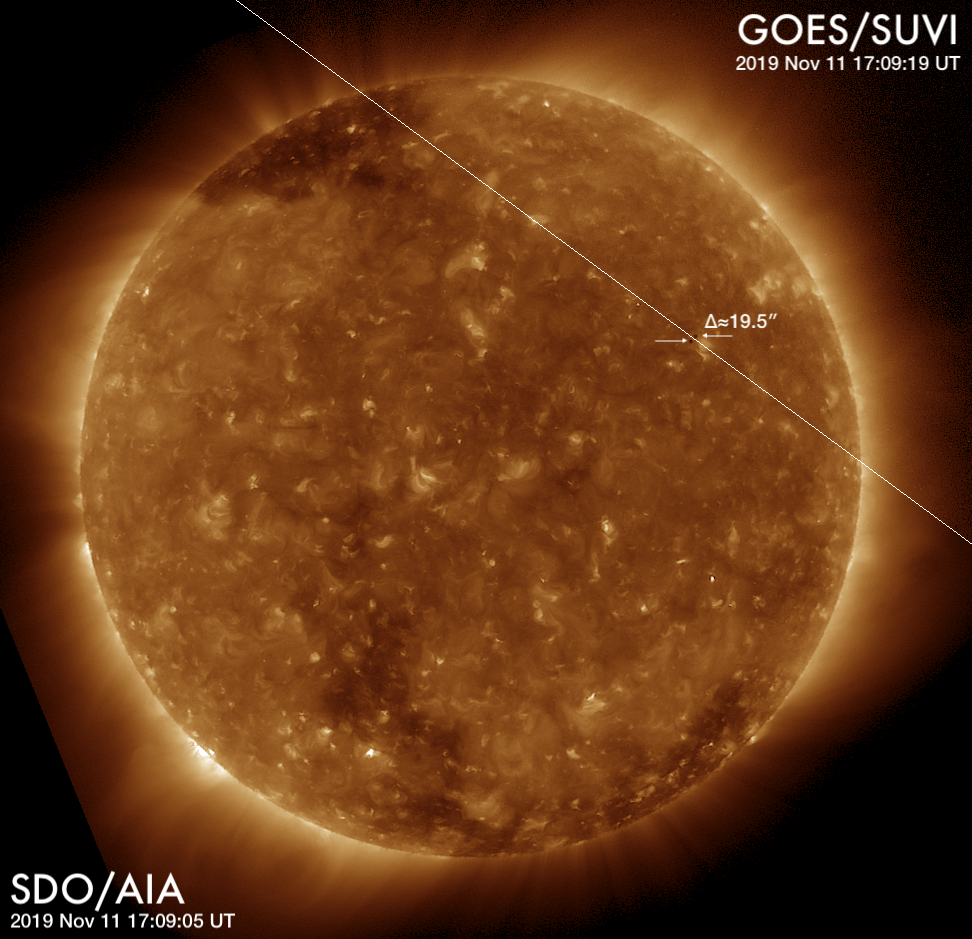
Views of the Mercury transit from the GOES-16 Solar Ultraviolet Imager (SUVI) in its 195Å and 304 Å passbands, between 11 and 19 UT on 2019 November 11. (Daniel B. Seaton/Univ. of Colorado/NOAA)
SUVI Movies (11/11/2019) (Credit: Daniel B. Seaton)
- SUVI Mercury 304 unannotated
- SUVI Mercury 304 annotated
- SUVI Mercury 195 unannotated
- SUVI Mercury 195 annotated
A quick-look movie using the TiO speckle reconstructed data for the 2019 Mercury transit. (Big Bear Solar Observatory)
Black drop: From the Big Bear Solar Observatory –
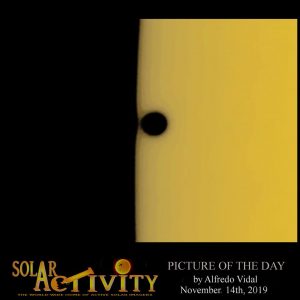
Black-drop image by Alfredo Vidal <[email protected]> Solar Activity Picture of the Day for November 14th, 2019. “The world wide home of active solar imagers”
Celestron C11 Edge HD F:10 telescope working at primary focus with a Baader ND-5.0 Solar Screen Filter Mylar sheet + ZWO ASI290MM monochrome camera with Continuum Baader green filter from the terrace of his home in Hospitalet del Llobregat (Barcelona/Spain).
The resulting video record was made in black and white. Subsequently and with the use of the public domain program: VirtualDubMod uses various VDF digital filters (plugins) provided by the program to give: false color, improve contrast, noise removal, etc., in order to obtain a single frame in which you can interpret the “black drop.”
Traffic Video:
https://www.facebook.com/photo.php?fbid=10218295151643934&set=gm.2777831062228220&type=3&theater&ifg=1
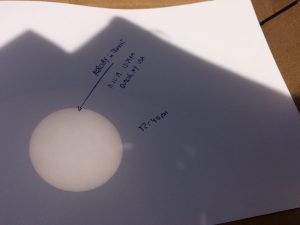
Projected Transit of Mercury observed by Christine and Evan Lockwood in Quogue, NY, on November 11, 2019.
- Pasachoff, Jay M., 2019, “Mercurio in Sole Visu,” Progetto Alternanza Scuola-Lavoro, a 15-min narrated talk.
- From Glenn Schneider
- Capturing the Transit of Mercury – Sky & Telescope
- New York Times 2019 Transit of Mercury Article
- Astronomer Jay Pasachoff, Students, and Colleagues to Observe the Last Transit of Mercury until 2032
- November 11 Live Stream for Transit of Mercury – Streaming from the Pontifical University (Thomas Puzia) in Santiago, Chile
- The Instituto Geofísico del Perú (IGP) Live Transmission Facebook Page
- Slooh to Livestream Rare Transit of Mercury
-
HD Livestream – Mercury Transit 2019 – from Santiago de Chile
Transit of Mercury 2019 Powerpoint-
Source: http://xjubier.free.fr/en/site_pages/transits/ToM_2019.html
November 11, 2019:
Xavier Jubier’s sites
http://xjubier.free.fr/en/site_pages/transits/ToM_2019.html
Fred Espenak’s EclipseWise site
http://www.eclipsewise.com/oh/tm2019.html
PROBA2 Mercury-transit observations
https://proba2.sidc.be/mercurytransit2019
Time-and-date.com site
https://www.timeanddate.com/eclipse/transit/2019-november-11
Robert Lucas from Embry-Riddle Aeronautical University, Daytona Beach, Florida, with a Canon 60Da with the 800 mm mirrored lens. 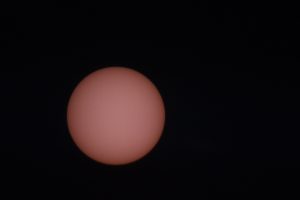
- November 13, 2032
- November 7, 2039
- May 7, 2049
- November 9, 2052
- May 10, 2062
- November 11, 2065
- November 11, 2078
- November 7, 2085
- May 8, 2095
- November 10, 2098
_____________________________________________________________________________
Jay M. Pasachoff and Alex Filippenko, The Cosmos: Astronomy in the New Millennium, 5th ed., Cambridge University Press, 2019. (See p. 154 for transits of Mercury and p. 269 for applications to exoplanet transits.) A review of “The Cosmos” was published in Physics Today: Kristen Thompson, Phys. Today, 73(3), 54-55 (2020). https://physicstoday.scitation.org/doi/10.1063/PT.3.4434
